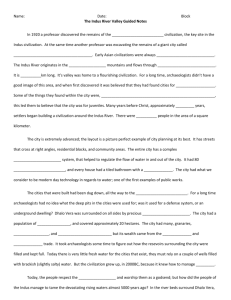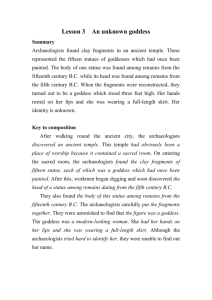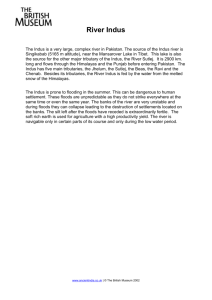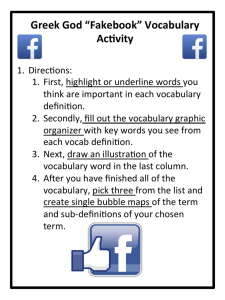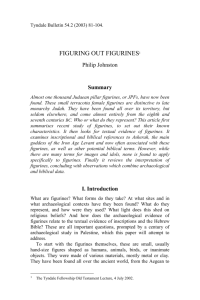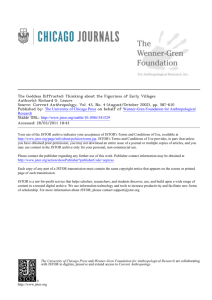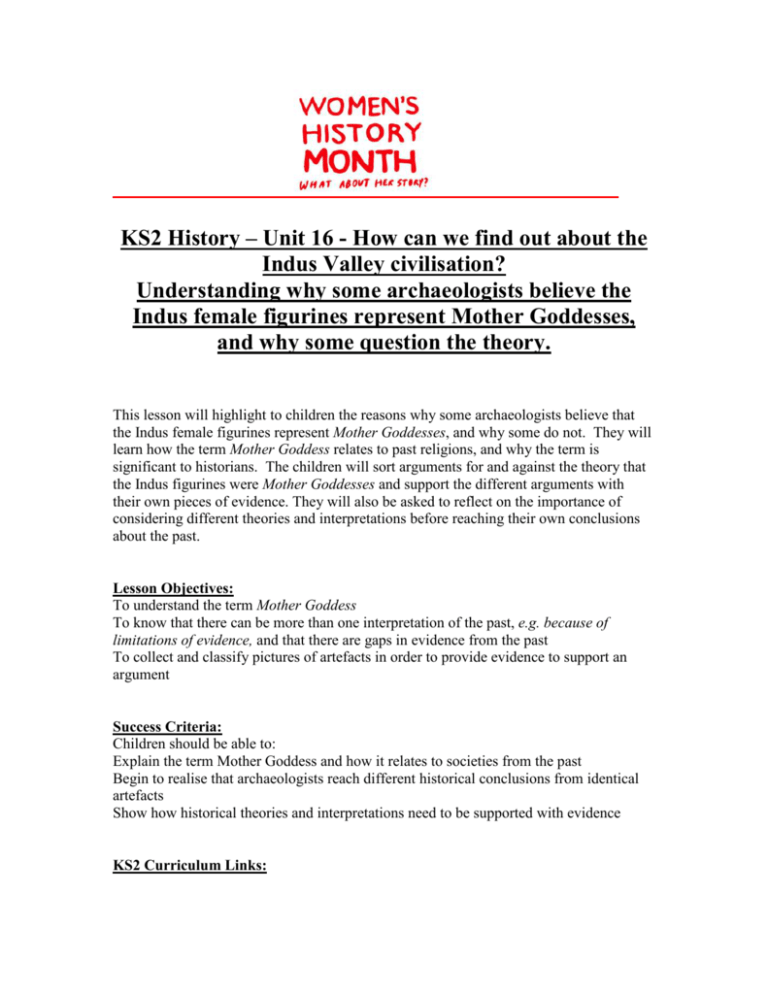
KS2 History – Unit 16 - How can we find out about the
Indus Valley civilisation?
Understanding why some archaeologists believe the
Indus female figurines represent Mother Goddesses,
and why some question the theory.
This lesson will highlight to children the reasons why some archaeologists believe that
the Indus female figurines represent Mother Goddesses, and why some do not. They will
learn how the term Mother Goddess relates to past religions, and why the term is
significant to historians. The children will sort arguments for and against the theory that
the Indus figurines were Mother Goddesses and support the different arguments with
their own pieces of evidence. They will also be asked to reflect on the importance of
considering different theories and interpretations before reaching their own conclusions
about the past.
Lesson Objectives:
To understand the term Mother Goddess
To know that there can be more than one interpretation of the past, e.g. because of
limitations of evidence, and that there are gaps in evidence from the past
To collect and classify pictures of artefacts in order to provide evidence to support an
argument
Success Criteria:
Children should be able to:
Explain the term Mother Goddess and how it relates to societies from the past
Begin to realise that archaeologists reach different historical conclusions from identical
artefacts
Show how historical theories and interpretations need to be supported with evidence
KS2 Curriculum Links:
History – 3: Pupils should be taught to recognise that the past is represented and
interpreted in different ways, and to give reasons for this, 4b: to record information
relevant to the focus of the enquiry
Religious Education – 1e: to identify and suggest meanings for religious symbols and
begin to use a range of religious words
Literacy – Reading 3g: to consider an argument critically
Resources:
Powerpoint
Card matching game
Images of figurines and other Indus artefacts, (including images of female figurines with
babies, male figurines and children figurines).
Internet, including websites:
http://www.harappa.com/teach/
http://www.harappa.com/figurines/index.html
http://www.harappa.com/investigators/meet.html
http://www.harappa.com/investigators/plenty.html
http://www.imagesofasia.com/subject/html/mohenjodaro/Figurines-4.html
http://www.bbc.co.uk/schools/primaryhistory/indus_valley/
Teaching Activity / Introduction
Show the children a selection of pictures of female figurines found across the Indus
Valley. Explain to the children that many archaeologists believe the female figurines
represent Mother Goddesses, but that some are not so sure about this theory. Explain to
them that they are going to find out the reasons why archaeologists have different
opinions about the figurines.
Explain to the children that they need to understand the term Mother Goddess first. Ask
them to look at various pictures that show examples of artefacts from around the world
that are meant to represent Mother Goddesses (Powerpoint).
Ask the children to list what the possible different uses for a Mother Goddess could be.
Then explain to the children that Mother Goddess is a term often used to refer to a
goddess, worshipped in a period of history, who is supposed to have represented
motherhood, fertility and creation, or embodied the bounty of the Earth. Then ask them
to look at the pictures again and ask them if they have any further ideas or questions.
Point out to the children that archaeologists like to establish whether societies from the
past worshipped Mother Goddesses because it tells them a lot about the people and their
religious views at the time.
Development
Paired/Group Activity
Ask the children to read cards showing all the arguments in favour of the theory that the
female figurines were Mother Goddesses. Then hand out all the opposing arguments.
The children match them up and sort them into two columns: For and Against. Go
through the answers as a whole class and ask the children if they have any questions.
Independent Activity
Ask the children to look at more pictures of artefacts from the Indus Valley and decide
whether they could be used to support the ‘For’ or ‘Against’ arguments. For example, the
children might decide that a picture of a figurine holding a baby supports the theory of a
Mother Goddess.
Differentiation
G&T – Hand out all the cards together and ask the children to match them up, OR ask the
children to investigate examples of Mother Goddesses from other periods in history in
order to use them as a way of backing up or refuting the theory of an Indus Mother
Goddess.
SEN – Ask the children to match and sort numbered and alphabetised cards.
Plenary
Ask for a series of predictions in regard to the theory of the Indus Mother Goddess. For
example, children complete the following statements: I predict archaeologists will
prove/not prove in 100 years’ time that the Indus worshipped a Mother Goddess
because…..OR.. ask them to list all the disadvantages of worshipping a Mother Goddess.
Ask the children why they think it is important to find examples from history to back up
archaeological theories. Would anyone take them seriously as an archaeologist if they
didn’t?
End by explaining to the children that being an archaeologist is sometimes about
challenging established theories. This means that archaeologist’s views about past
societies can differ greatly. For example, some archaeologists believe that the existence
of a Mother Goddess in a society proves that the women in that society had great power
and status (matriarchies). Others believe models of so-called Mother Goddesses were
simply not much more than toys and that women were not in charge!
[Teacher Note: Alternative theories of the Indus female figurines:
1 - They were ornaments or toys of different types of Harappan people
2 – They were cult figures
3 – They were part of a religion that included myth, magic and ritual and do not represent
an all-powerful mother goddess.]
Extension/Homework
Ask the children to investigate the goddesses of modern Hinduism. Can they find any
examples of goddesses that have links with the figurines of the Indus, and some that
don’t?
Possible Follow-Up Lesson
Ask the children to list all the attributes of the female and male Indus figurines, and then
combine the attributes into a design for a single figurine.
Copyright 2011-12 © womenshistorymonth.org.uk. All rights reserved.
www.womenshistorymonth.org.uk
This lesson plan was created with the help of Teach Indus. Any
images used from www.Harappa.com are copyright and for educational
use only.



